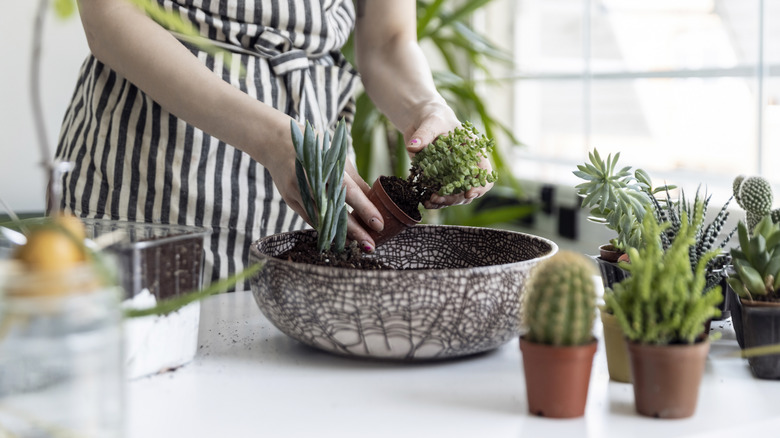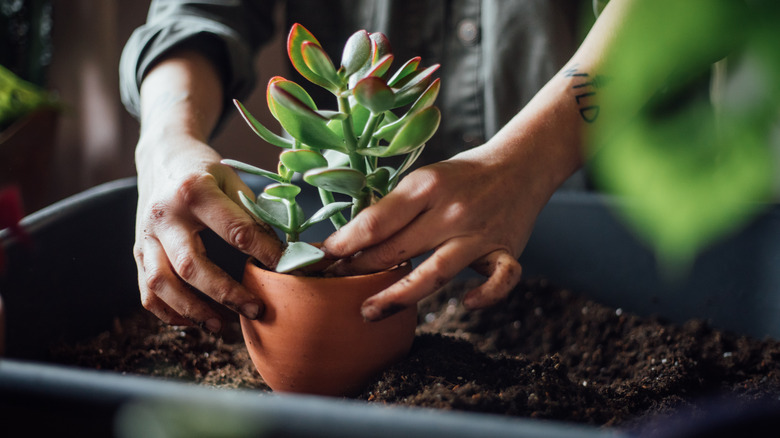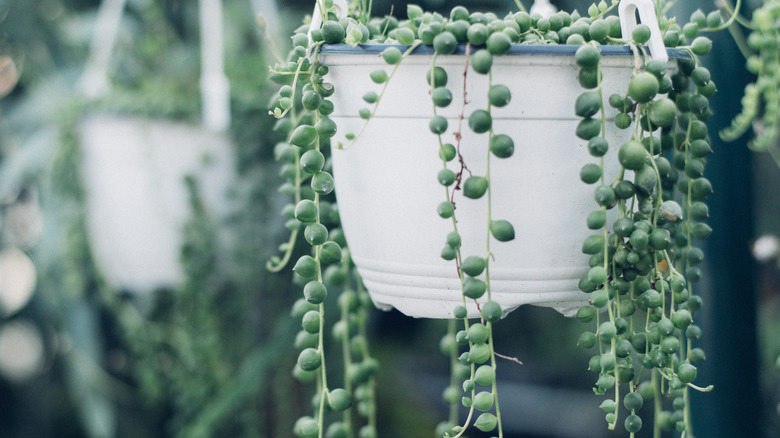DIY A Thriving Succulent Planter With Martha Stewart's Expert Tips
Hailing from warm, desert climates, succulents have made their way into many homes despite the lack of conditions mimicking their natural habitats. Nevertheless, succulents add visual interest to any space and are relatively easy to care for compared to other more needy tropical plants that have become trendy as of late. Even Martha Stewart, on her blog, endorses these adorable hardy plants: "If you like growing plants, but don't really have a lot of time to care for them, I encourage you to consider growing succulents." That all being said, like any plant, a succulent does have particular needs that, if met, will allow them to be maintained with minor adjustments and just a little attention.
Another reason succulents have become so popular in home decor and design is due to the seemingly endless variety of options to choose from. Whether you want a small container plant, a trailing plant with dangling vines, or something with a bright pop of color, there is a succulent out there to fit your desire. In an interview on the "TODAY Show," Martha Stewart says, "They are very colorful and so diverse in shape and size." What's great about succulents, too, is that they have become readily available in many stores due to their popularity. While you will probably have the best of luck in longevity adopting a plant from a local nursery, plant boutiques, hardware stores like Home Depot, and even grocery stores have also begun to carry these interesting little plants.
Stewart's tips for planting succulents
Creating a succulent planter is a fun and rewarding project that adds a touch of greenery to any space. First, the choice of soil is crucial for the health and growth of your succulents. Succulents thrive in well-draining soil that allows excess water to escape easily. On her blog, Martha Stewart recommends, "We use a mix of sand, perlite and vermiculite for best drainage. The right soil mix will help to promote faster root growth, and gives quick anchorage to young roots." This mixture mimics the natural habitat in which succulents thrive.
In addition to soil, overall drainage is a key factor in succulent care. Without proper drainage, excess water can lead to root rot and other issues. It is essential to have drainage holes to allow water to escape. If your planter does not have pre-drilled holes, you can create them using a drill or hammer and nail.
When it comes to planting your succulents, start by filling the planter with the soil mix, leaving enough space for the plants. Gently remove the succulents from their nursery pots, minding the delicate roots. Place the succulents in the planter, positioning them securely. Arrange them in a way that creates an aesthetically pleasing composition.
After planting, water your succulents properly. Allow the soil to dry out completely between waterings, and when you do water, make sure to thoroughly saturate the soil. Avoid getting water on the succulents' leaves, which can lead to rot.
Best succulents for a planter
When it comes to choosing the best succulents for your planter, there are many options to consider. One of the most striking is a string of pearls. It's a unique succulent that gets its name from its cascading stems adorned with small, round leaves resembling pearls. Native to Africa, it's known for its trailing vines, making it an excellent choice for hanging planters. String of pearls requires bright, indirect light and well-draining soil. It is drought-tolerant and can go for long periods without water, making it a low-maintenance option for planters.
Echeveria is another popular succulent that includes a wide variety of species. They are known for their rosette-shaped leaves that come in various colors. On her blog, Stewart claims, "Echeverias are some of the most attractive of all succulents and they are highly valued by plant enthusiasts for their gorgeous colors and beautiful shapes." Native to Mexico, they require bright sunlight to maintain their vibrant colors. Echeverias are compact in size, making them suitable for small planters or arrangements.
Finally, hens and chicks are another popular choice. These plants form rosettes of fleshy leaves that grow in tight clusters, with the "hen" being the larger, central rosette and the "chicks" being the smaller offsets growing around it. Hens and chicks come in various colors and textures, ranging from green to red and even purple. They are hardy plants that can tolerate a range of conditions, including full sun to partial shade.


